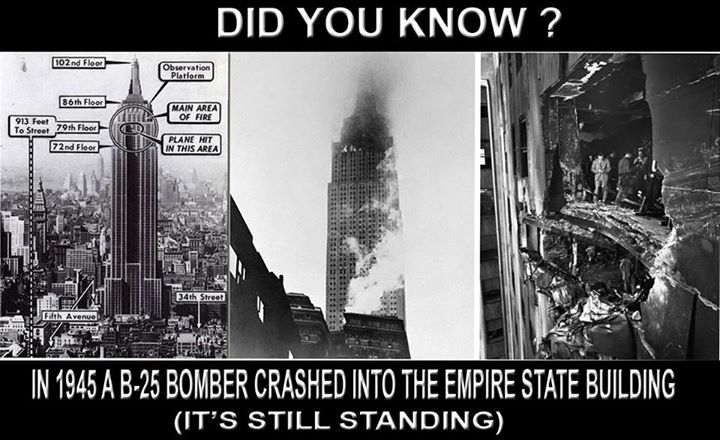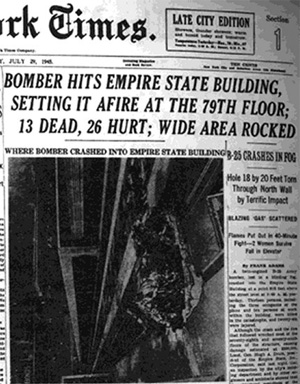South Dakota B-25 Crashes into Empire State Building, 7-28-45
 by Duke Doering
by Duke Doering
On July 28, 1945, Saturday, William Franklin Smith, Jr., was piloting a B-25 Mitchell bomber on a routine personnel transport mission from Bedford Army Air Field to Newark Airport. Smith asked for clearance to land, but was advised of zero visibility. Proceeding anyway, he became disoriented by the fog, and started turning right instead of left after passing the Chrysler Building. At 9:40 a.m., the aircraft crashed into the north side of the Empire State Building, between the 78th and 80th floors, carving an 18-by-20-foot (5.5 m × 6.1 m) hole in the building where the offices of the National Catholic Welfare Council were located. One engine shot through the South side opposite the impact and flew as far as the next block, dropping 900 feet and landing on the roof of a nearby building and starting a fire that destroyed a penthouse. The other engine and part of the landing gear plummeted down an elevator shaft. The resulting fire was extinguished in 40 minutes. It is still the only fire at such a height to be brought under control.
 The B-25 bomber had left Sioux Falls Army Airfield at 7:29 a.m. Thursday morning, July 26 carrying nine combat returnees. Maj. Harold A. Patterson, public relations officer at the Sioux Falls field said the ship was cleared here for the Newark, NJ airport via Cleveland. He also said the bomber involved in the crash was one that had been assigned to Sioux Falls. When the plane left here, Lt. Col. William F. Smith was the co-pilot and Tech. Sgt. Christopher S. Domitrovich was the crew chief. Both died when the big plane smashed into the building on July 28. Nine others who left the Sioux Falls air field aboard the ship left it in Newark. After reaching Newark, the plane cleared for Bedford, Mass., and at the time of the crash was en route to the Newark Airport. This was a routine flight and the plane was to return to Sioux Falls. The seven others aboard the ship when it took off from Sioux Falls were Col. Harris E. Rogner, who had served as the pilot on the flight to Newark, Lt. Cols. William C. Garland and Carl C. Hinkle; Maj. James A. Maguire; and Capts. F. F. Smithson, Colt Hamilton and Umbert Anz.
The B-25 bomber had left Sioux Falls Army Airfield at 7:29 a.m. Thursday morning, July 26 carrying nine combat returnees. Maj. Harold A. Patterson, public relations officer at the Sioux Falls field said the ship was cleared here for the Newark, NJ airport via Cleveland. He also said the bomber involved in the crash was one that had been assigned to Sioux Falls. When the plane left here, Lt. Col. William F. Smith was the co-pilot and Tech. Sgt. Christopher S. Domitrovich was the crew chief. Both died when the big plane smashed into the building on July 28. Nine others who left the Sioux Falls air field aboard the ship left it in Newark. After reaching Newark, the plane cleared for Bedford, Mass., and at the time of the crash was en route to the Newark Airport. This was a routine flight and the plane was to return to Sioux Falls. The seven others aboard the ship when it took off from Sioux Falls were Col. Harris E. Rogner, who had served as the pilot on the flight to Newark, Lt. Cols. William C. Garland and Carl C. Hinkle; Maj. James A. Maguire; and Capts. F. F. Smithson, Colt Hamilton and Umbert Anz.
Fourteen people were killed: Smith, the two others aboard the bomber, Staff Sergeant Christopher Domitrovich and Albert Perna, a Navy aviation machinist’s friend hitching a ride was not found until two days later after search crews found his body had gone through an elevator shaft and fallen to the bottom, along with eleven people in the building. Elevator operator Betty Lou Oliver was injured. Rescuers decided to transport her on an elevator that they did not know had weakened cables. She survived a plunge of 75 stories, which still stands as the Guinness World Record for the longest survived elevator fall.
Despite the damage and loss of life, the building was open for business on many floors on the following Monday. The crash spurred the passage of the long-pending Federal Tort Claims Act of 1946, as well as the insertion of retroactive provisions into the law, allowing people to sue the government for the accident.
To this day, a missing stone in the facade serves as evidence of where the aircraft crashed into the building.
(The South Dakota Air National Guard was not established until 1946, the B-25 assigned to the Sioux Falls Army Airfield in 1945 belonged to the Army Air Corps)
 by Duke Doering
by Duke Doering The B-25 bomber had left Sioux Falls Army Airfield at 7:29 a.m. Thursday morning, July 26 carrying nine combat returnees. Maj. Harold A. Patterson, public relations officer at the Sioux Falls field said the ship was cleared here for the Newark, NJ airport via Cleveland. He also said the bomber involved in the crash was one that had been assigned to Sioux Falls. When the plane left here, Lt. Col. William F. Smith was the co-pilot and Tech. Sgt. Christopher S. Domitrovich was the crew chief. Both died when the big plane smashed into the building on July 28. Nine others who left the Sioux Falls air field aboard the ship left it in Newark. After reaching Newark, the plane cleared for Bedford, Mass., and at the time of the crash was en route to the Newark Airport. This was a routine flight and the plane was to return to Sioux Falls. The seven others aboard the ship when it took off from Sioux Falls were Col. Harris E. Rogner, who had served as the pilot on the flight to Newark, Lt. Cols. William C. Garland and Carl C. Hinkle; Maj. James A. Maguire; and Capts. F. F. Smithson, Colt Hamilton and Umbert Anz.
The B-25 bomber had left Sioux Falls Army Airfield at 7:29 a.m. Thursday morning, July 26 carrying nine combat returnees. Maj. Harold A. Patterson, public relations officer at the Sioux Falls field said the ship was cleared here for the Newark, NJ airport via Cleveland. He also said the bomber involved in the crash was one that had been assigned to Sioux Falls. When the plane left here, Lt. Col. William F. Smith was the co-pilot and Tech. Sgt. Christopher S. Domitrovich was the crew chief. Both died when the big plane smashed into the building on July 28. Nine others who left the Sioux Falls air field aboard the ship left it in Newark. After reaching Newark, the plane cleared for Bedford, Mass., and at the time of the crash was en route to the Newark Airport. This was a routine flight and the plane was to return to Sioux Falls. The seven others aboard the ship when it took off from Sioux Falls were Col. Harris E. Rogner, who had served as the pilot on the flight to Newark, Lt. Cols. William C. Garland and Carl C. Hinkle; Maj. James A. Maguire; and Capts. F. F. Smithson, Colt Hamilton and Umbert Anz.